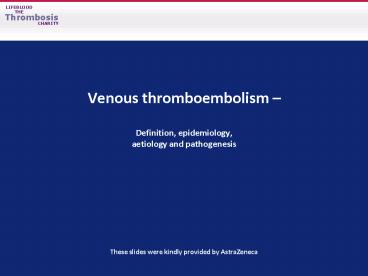Venous thromboembolism - PowerPoint PPT Presentation
1 / 26
Title:
Venous thromboembolism
Description:
These s were kindly provided by AstraZeneca. Ulcus cruris ... Normal PA chest radiograph. Pulmonary hypertension PA chest radiograph. Prominent pulmonary ... – PowerPoint PPT presentation
Number of Views:968
Avg rating:3.0/5.0
Title: Venous thromboembolism
1
Venous thromboembolism Definition,
epidemiology, aetiology and pathogenesis The
se slides were kindly provided by AstraZeneca
2
Venous thromboembolism
DVT
PE
Deep vein insufficiency
Post-thrombotic syndrome
Pulmonary hypertension
Death
Ulcus cruris
Chronic PE
3
Deep vein thrombosis
Common femoral vein
Thrombus
Proximal
Knee
Distal
Veins of the leg
4
Post-thrombotic syndrome
- Pain
- Oedema
- Discoloration
- Varices
- Ulceration
Symptoms of post-thrombotic syndrome long
lag-phase (years)
5
Post-thrombotic syndrome
6
Ulcus cruris venosum
7
Severe stasis and ulceration
8
Embolus
Pulmonaryvein
Pulmonary artery
Leftatrium
Rightatrium
Rightventricle
Leftventricle
9
Thrombus formation in a deep vein
10
A fragment of a thrombus travelling towards the
lungs
11
Pulmonary embolism
Embolus
Dyspnea, syncope, hypotension, cyanosis
12
Pulmonary embolism kills
13
Pulmonary embolism
Embolus
Pleuritic pain, cough, haemoptysis Symptoms may
be vague or absent
14
Venous thromboembolism (VTE)
Pulmonary embolism
Deep vein thrombosis
15
Normal PA chest radiograph
16
Pulmonary hypertension PA chest radiograph
Prominent pulmonary artery segment
Enlarged, but pruned proximal pulmonary artery
17
Venous thromboembolism is a major problem
Estimated annual incidence rates in the USA
DVT 2 million
Post- thrombotic syndrome 800,000
Silent PE 1 million
PE 600,000
Pulmonary hypertension 30,000
Death 100,000
Hirsh J Hoak J. Circulation 1996 93221245
18
Classification of level of VTE risk
Low risk
High risk
Highest risk
Moderate risk
- Surgery inpatients with multiple risk factors
(age gt40, cancer, prior VTE) - Hip or knee arthroplasty, hip fracture surgery
- Major trauma, spinal cord injury
- Surgery inpatients 40-60years with
noadditional risk factors - Minor surgeryin patients with additional risk
factors
- Minor surgery in patients lt40years with no
additional riskfactors
- Surgery inpatients gt60years, or age 40-60 with
additional risk factors (prior VTE, cancer,
molecular hyper-coagulability)
Geerts WH et al. Chest 2004126338S400S
19
Thromboembolic risk categories
Frequency offatal PE ()
Frequency ofcalf DVT ()
Frequency ofproximal DVT ()
Category
Highest risk 40-80 10-20 0.2-5 High
risk 20-40 4-8 0.4-1.0 Moderate
risk 10-20 2-4 0.1-0.4 Low risk 2 0.4 lt0.01
Geerts WH et al. Chest 2004126338S400S
20
VTE risk factors
Persistent
Transient
- Pregnancy
- Oral contraceptives
- Hormone replacement therapy
- Immobilisation
- Surgery
- Acquired
- Age
- History of VTE
- Malignancy
- Antiphospholipid antibody syndrome
- Genetic
- Thrombophilia
21
Thrombophilia and risk of recurrence
Risk importance
- Antithrombin deficiency
- Homozygous factor VLeiden
- Combined defects
- Antiphospholipid antibodies (LA/ACA)
- Protein C deficiency
- Protein S deficiency
- Heterozygous factor VLeiden
- Heterozygous prothrombin gene mutation
Risk
22
Pathogenesis of VTEVirchows triad
Rudolf Virchow
23
Pathogenesis of VTE Virchows triad
Stasis
Injury to the vessel wall Damage to the vessel
wall can be produced by direct trauma such as
major hip or knee surgery, stab wounds or
insertion of venous catheters, by direct invasion
from cancer cells, or as a consequence of age.
Support structures in vessel walls deteriorate
with age, leading to weakness and a
predisposition to damage from distension.
Hypercoagulability
24
Pathogenesis of VTE Virchows triad
Injury to the vessel wall
Stasis Stasis describes the slowing or even
cessation of blood flow. This commonly occurs in
veins as a result of immobility or paralysis and
can lead to concentration and subsequent
activation of coagulation factors. Stasis can
also cause the vessel walls to become distended,
resulting in endothelial damage.
Hypercoagulability
25
Pathogenesis of VTE Virchows triad
Stasis
Injury to the vessel wall
Hypercoagulability The term hypercoagulability
means an increased propensity to clot.
Hypercoagulability can occur as a result of a
genetic defect, stasis, malignancy or hormone
changes such as during pregnancy, during
administration of oral contraceptives or hormone
replacement therapy.
26
6. Vessel wall with activated endothelium
(colour-enhanced scanning electron
micrograph) This scanning electron micrograph
shows how the endothelium has reacted to
compression and damage during surgery. The
endothelial cells are activated and the clotting
cascade has started. The formation of thrombin is
the pivotal step in fibrin formation and thrombus
development.































